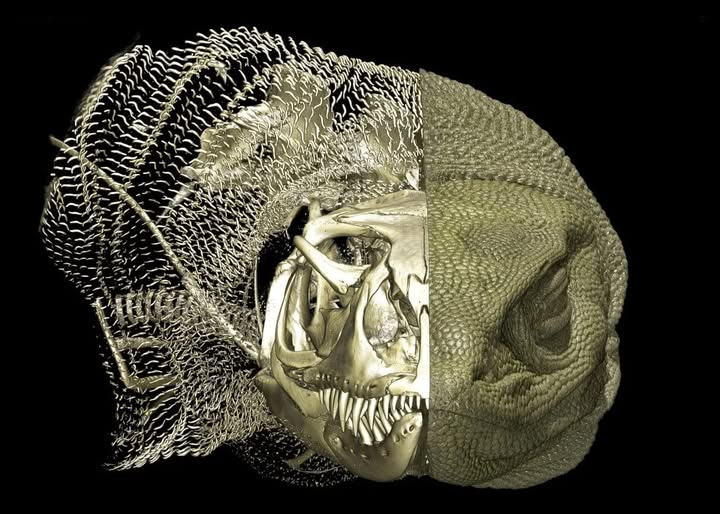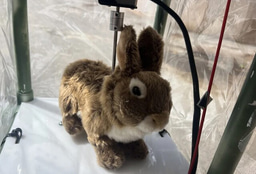

🦎 In a global study, scientists discovered osteoderms (bony structures found in the skin) in 29 species of monitor lizards, which significantly expanded our knowledge of reptile evolution.
👉Published on July 21 in the Zoological Journal of the Linnean Society, the study is the first comprehensive global analysis of osteoderms in lizards and snakes. The study was conducted by an international team of scientists from Australia, Europe, and the United States. Using advanced micro-CT scanning technology, the researchers examined nearly 2,000 reptile specimens from major museum collections, including the Research Institute of the Museum of Victoria.
🕵 Osteoderms are typically associated with animals like crocodiles, armadillos, and certain dinosaurs such as Stegosaurus. The study significantly expands our knowledge of these bone structures. Researchers have discovered that osteoderms are present in almost half of all lizard species worldwide, which represents an 85% increase over previous estimates.
👩🔬 What is important about this discovery is that it changes our current understanding of reptile evolution. It suggests that osteoderms may have evolved in response to environmental pressures as lizards adapted to the harsh conditions of Australia. Until now, the presence of osteoderms in monitor lizards was considered rare and occurred mainly in Komodo dragons.
🦎 This groundbreaking study not only opens a new chapter in the history of Australian monitor lizards, but also provides a powerful new dataset that will allow us to explore how skin, body structure, and survival have been linked over millions of years of evolution.
👉 If you want more information, I encourage you to read the references:
Roy Ebel, Chris Broeckhoven, Edward L Stanley, Till Ramm, J Scott Keogh, Dermal armour in lizards: osteoderms more common than presumed, Zoological Journal of the Linnean Society, Volume 204, Issue 3, July 2025, zlaf070
More interesting facts from the world of herpetology on my new page:
https://www.facebook.com/profile.php?id=61573408584356
PHOTO: Rosenberg goanna (Varanus rosenbergi WAM R95408) with osteoderms and endoskeleton revealed in the left half. Credit: Roy Ebel
#varanus #varanids #monitorlizards #lizards #sauria #nature #herpetology #bones #animals #science #osteoderms #review #squamata #lizards




Please sign in or register for FREE
If you are a registered user on WildHub, please sign in
🦎 Absolutely intriguing, Przemyslaw, thank you for shedding light on this groundbreaking study! The sheer scope and rigor behind analyzing nearly 2,000 specimens using micro-CT scanning is commendable, and the 85% increase in known osteoderm presence is astonishing.
This discovery doesn’t just rewrite our assumptions about monitor lizard anatomy; it stirs broader questions about evolutionary biology and survival strategies. If osteoderms are found in nearly half of all lizard species, could they be a universal ecological response, shaped by environmental challenges across diverse habitats? I wonder how these adaptations vary regionally and whether similar pressures have triggered osteoderm development in other reptiles or even amphibians.
Moreover, the Australian context adds such a compelling layer, with its extreme climates and rich biodiversity, which makes me curious how these armored traits play into predator-prey dynamics or thermoregulation. Could osteoderm density correlate with geographical harshness or resource scarcity?
Would love to hear your thoughts on how this new dataset might inform future field studies or museum curation. Are there any plans to expand this research to African monitor species? Your work continues to open doors not just for herpetology but for cross-disciplinary conservation insights.
Thanks again for making this complex topic so digestible and for inspiring curiosity across borders. Looking forward to seeing how this sparks new collaborations and questions in the WildHub community! 🙌
Thank you very much for your comment. It is precisely research like this that we need. Research that opens up so many possibilities and raises so many interesting questions and issues for action.
Thermoregulation and osteoderms (even in the context of extinct animals such as Stegosaurus), the formation of osteoderms based on predator pressure, or the type of biotope are topics for many groundbreaking studies, in the context of global or local populations.
I always quietly hope that this type of papers and their wide sharing will inspire people who want to get involved in ecology and animal evolution.
best reagrds,
Przemyslaw